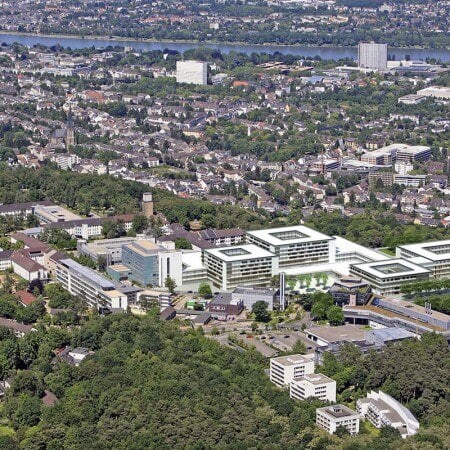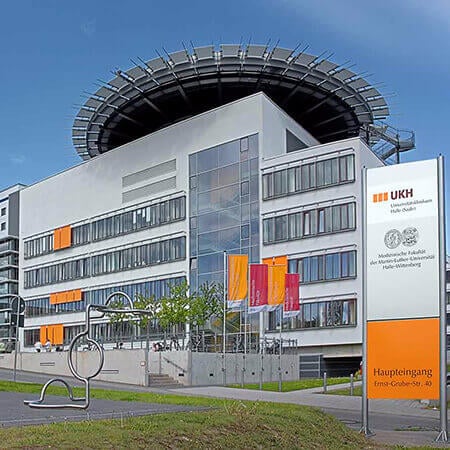Retinoblastoma is cancer of the retina of the eye. It is a tumor of neuroectodermal origin that grows from the optic part of the retina. Up to 40% of patients have a hereditary form of this type of cancer. It accounts for most of the cases of binocular retinoblastoma, which causes damage to both eyes. The remaining 60% of cases are sporadic and are usually accompanied by the development of a tumor in only one eye. Actually, a child may be already born with the tumor, but the cancer is rarely detected at birth. Booking Health offers efficient treatment regardless of the patient’s age. On the Booking Health website you will find the list of the specialized hospitals, information about the novel therapeutic methods, and costs of treatment.
Content
- How common is retinoblastoma?
- Symptoms of retinoblastoma
- Diagnosis of retinoblastoma
- Treatment of retinoblastoma
- Where to undergo treatment for retinoblastoma?
How common is retinoblastoma?
Retinoblastoma in children makes 3-4% of all malignant neoplasms. It accounts for 95% of all cases of eye cancer, which makes it the most common eye cancer in children. Due to these, retinoblastoma constantly stays in the center of attention of neonatologists, pediatricians, and oncologists.
In 80% of cases, the disease is detected before the age of 4 years. The peak incidence of bilateral retinoblastoma occurs in the first year of life, while unilateral retinoblastoma often develops at the age of 2-2.5 years. The average age of newborns and toddlers diagnosed with this cancer type is 18 months old; children of both sexes are affected equally.
Retinoblastoma is a type of pediatric cancer and rarely develops in adults. This is connected with the genetic background of the pathology: genetic conditions manifest themselves early. If an adult is diagnosed with retinoblastoma, the therapeutic protocol does not have any significant differences compared to the pediatric one.
As for the epidemiology and incidence of retinoblastoma worldwide, the condition has no definite geographic prevalence. However, patients from the low- and middle-income countries were often diagnosed at an older age than children in high-income countries; stage of cancer was also more advanced in the first case. The same conclusions are applicable to treatment outcomes: children from high-income countries had the highest chance to live cancer-free after treatment.
Symptoms of retinoblastoma
This type of eye cancer is visible during non-specialized examination. Often, healthcare professionals find it during a routine well-baby examination. In addition, children who have a family history of retinoblastoma must be examined shortly after birth; it is better to visit an ophthalmologist who specializes in eye cancer.
If the pathology hasn’t been found during the routine examination, it may progress and cause clinical manifestations. Older children tell parents about their complaints, or parents can notice certain abnormalities by themselves.
Leukocoria (white pupil) is the first noticeable sign of retinoblastoma. The pupil looks white or cloudy and may be dilated regardless of the lighting. It may look white when looking at certain angles or in a photo with a flash.
Others the most typical symptoms of retinoblastoma include:
- Blurred vision.
- Eye redness.
- Strabismus (squint).
- Eye bleeding.
- Eyeball protrusion.
- Lack of pupillary response to light.
- Different eye color.
Some complaints are connected directly with the affection of the retina and presence of the tumor inside the eye socket, others develop after the involvement of blood vessels, eye muscles, and ophthalmic nerve. After spreading outside the eye, general complaints develop, such as headache, loss of appetite and vomiting, weight loss, presence of lumps under the skin in the head and neck.
Despite being not unique for eye cancer, these symptoms are indicative of ophthalmological pathology and require medical attention. Noticing them, you must see your general practitioner or schedule a visit to an ophthalmologist. It's unusual for eye cancer to progress unnoticed and visiting a doctor early leads to better treatment outcomes.
Diagnosis of retinoblastoma
Should retinoblastoma be suspected, the diagnosis of the disease is carried out using the following initial methods:
- Visometry
- Tonometry
- Biomicroscopy
- Scanning the fundus with a retinal camera
- Direct and reverse ophthalmoscopy
In order to avoid unnecessary stress for a child, all examinations are carried out under general anesthesia. This means that a child receives medicines through a vein and stays asleep throughout the examination. Results of examinations that are performed under sedation are more reliable, as general anesthesia avoids undesirable child’s movements, crying, etc.
Doctors at specialized eye centers use optical coherence tomography to confirm the diagnosis, as well as electrophysiological tests for the eye. The optical coherence tomography allows obtaining clear and detailed images of the retina, so that even the retinoblastoma with thickness under 1 mm is visible. This is a relatively new diagnostic technique that provides healthcare professionals with reliable information without exposing a patient to radiation.
Genetic testing is also carried out in order to identify children with heritable retinoblastoma. These are single-gene testing (next-generation sequencing aimed at screening of RB1 gene mutations) and chromosomal microarray. It should be mentioned that the most informative material for genetic testing is a sample of the eye tumor. Since tumor biopsy is not included in the diagnostic protocol due to high risk of complications, genetic testing is most often carried out after surgery, i.e. after the removal of the entire eye.
Visualizing studies also have high diagnostic value. MRI scan of the brain and orbits is carried out in order to detect cancer spreading beyond the orbital cavity. A CT scan is performed instead of an MRI in patients older than 1 year. A skeletal scintigraphy is also indicated to patients older than 1 year, this diagnostic test is aimed at the detection of bone metastases of eye cancer. Looking for metastatic foci is extremely important when doctors make a choice between a surgery and chemotherapy as first-line treatment options, or decide whether radiation therapy is necessary.
Lumbar puncture, or spinal tap. During the procedure a sample of cerebrospinal fluid is taken in order to look for cancer cells. If cancer cells are present, then doctors can suspect spreading of the malignant process to the brain or spinal cord. This requires additional examinations and therapeutic measures.
Bone marrow aspiration from the pelvic bone is carried out to see if the cancer has spread to the bone marrow. In this case such additional treatment as bone marrow transplantation may be included in the therapeutic protocol.
Hearing test is the additional examination that is indicated to children who receive the specific types of chemotherapy. In prolonged chemotherapy, some drugs can potentially lead to hearing loss, and doctors perform screening in order to detect and avoid this complication timely. Most modern chemotherapy regimens are not connected with such a complication.
Treatment of retinoblastoma
Retinoblastoma is often detected at an early stage. Therefore, the prognosis for curing the disease and preserving the eye for most children is favorable. If treated correctly and timely, more than 9 out of 10 patients with retinoblastoma are cured. The following methods can be used for retinoblastoma treatment abroad:
Organ-preserving treatments are the first-line therapeutic options in small tumors. These include laser therapy (photocoagulation or thermotherapy) and cryotherapy (cryoablation). In the first case a tumor is destroyed with the help of high temperatures, in the second – with the help of low temperatures. The treatment is effective in the early stages of the disease. In total, 2-3 procedures are required, which take place under general anesthesia. Due to the targeted action, healthy eye structures remain safe. These methods can also be a part of a complex regimen: for instance, thermotherapy is often combined with radiation therapy and chemotherapy.
Depending on the way of administration, chemotherapy may be systemic or topical. Systemic chemotherapy involves the intravenous or oral administration of drugs. Systemic chemotherapy is administered when a doctor suspects retinoblastoma spreading after receiving the results of MRI | CT scan. Advantage of such chemotherapy regimen is its ability to target all tumor foci, regardless of their localization.
Early-stage retinoblastoma is often treated with topical chemotherapy. The types of such chemotherapy are as follows:
- Selective intra-arterial chemotherapy is a treatment option when drugs are injected into the ophthalmic artery with a catheter, sometimes using a balloon occluder. An important advantage is that only 10% of the standard dose of chemotherapy is sufficient to destroy cancer cells effectively. This allows avoiding the undesirable and severe systemic side effects.
- Intravitreal chemotherapy is used in case of the endophytic growth of retinoblastoma. The drugs are injected into the vitreous body that is located right near the malignant formation.
Chemotherapy is used as the first treatment option before laser or other tumor removal, after surgery, and also in the advanced stages of retinoblastoma. It is rarely used as monotherapy.
Radiation therapy is another method for retinoblastoma treatment abroad. External beam radiation therapy for retinoblastoma is used extremely rarely, as it causes many side effects due to the tumor location near the brain and other vital structures. Local radiation therapy, i.e. brachytherapy, is usually used. The essence of the method consists in suturing a radioactive ophthalmic applicator to the sclera. The small radioactive plates are left inside the eye socket for a few days; this is enough to destroy a tumor. Brachytherapy is a safe type of radiation therapy that is effective for neoplasms up to 6 mm in size.
Surgical technique (eye enucleation) can be used for retinoblastoma stage 3 and above, or in the failure of other treatments for an early stage tumor. Surgery to treat large retinoblastomas involves the removal of the eye along with a section of the optic nerve. Instead, a silicone implant is placed. It is attached to the muscles to allow movement in sync with the other eye. Such intervention removes a cosmetic defect but does not allow restoring vision.
Where to undergo treatment for retinoblastoma?
Treatment for retinoblastoma in one of the eye clinics in Germany allows patients to cure cancer while avoiding the removal of the eye. Treatment for retinoblastoma in Switzerland may also be the best choice for some patients. The cost of treatment in this country is quite high compared to prices for medical services in other countries, but the level of medicine is one of the highest in the world.
You are welcome to use the services of the Booking Health company to find information about hospitals and therapeutic options, as well as undergo your treatment abroad. We offer the following benefits:
- The choice for treatment for retinoblastoma is a clinic that specializes in the removal of malignant eye tumors and achieves the best results.
- Making a treatment appointment on the preferred dates.
- A shorter waiting period for retinoblastoma treatment in Germany.
- Direct communication with a future attending ophthalmologist.
- Reduced cost of treatment abroad due to the exclusion of additional taxes and fees for foreign patients.
- Preparation of a medical program without repeating previously performed diagnostic tests, which allows reducing the final cost of treatment.
- Buying and forwarding medicines to your native country.
- Communication with a clinic after the completion of your treatment abroad.
- Organization of additional diagnosis, treatment, or rehabilitation.
The Booking Health company will provide quality services at the best price. We will book hotel and airline tickets for you, meet you at the airport and take you to the clinic by car. During your stay in Germany, we will support you 24/7.
Authors:
The article was edited by medical experts, board-certified doctors Dr. Nadezhda Ivanisova and Dr. Sergey Pashchenko. For the treatment of the conditions referred to in the article, you must consult a doctor; the information in the article is not intended for self-medication!
Sources:
National Cancer Institute
Ophthalmology Times
Science Direct
















